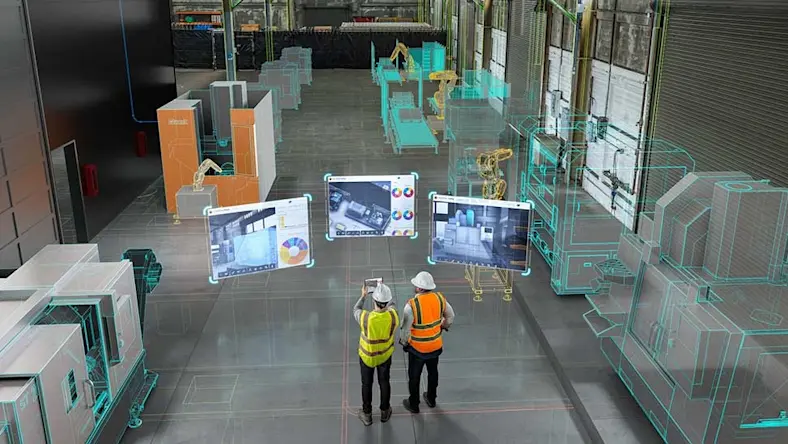& Construction

Integrated BIM tools, including Revit, AutoCAD, and Civil 3D
& Manufacturing

Professional CAD/CAM tools built on Inventor and AutoCAD
Stream a movie, hop on social media, or open an app on your smartphone, and you’re using a platform. Platforms are not only changing how businesses operate—breaking down silos, increasing collaboration, and creating opportunities for innovation—but also fast becoming the defining factor of success.
Back when companies followed a linear business model, developing products or services for customers was the main way to compete. But with that model, workflows were cobbled together with incompatible software programs, which led to an inefficient, siloed storage world. Innovation was capped by the limits of this piecemeal strategy. Platforms have changed that, disrupting traditional business models and creating new ways to innovate.
According to McKinsey, by 2025, digital platforms will account for 30% of global revenue, to the tune of $60 trillion. But despite that estimate, only 3% of companies have a platform strategy in place.
In industries where projects are typically distributed across multiple companies and time zones—such as architecture, engineering, and construction (AEC)—the need for a platform is especially critical. When everyone is using the same platform and not their own local, incompatible software, the construction process will go more smoothly.
Although AEC firms have been slow to adopt a platform way of thinking, the tide is changing. McKinsey reports that investors put $25 billion toward construction technology between 2014 and 2019. With the acceleration of digital transformation during the COVID-19 pandemic and the rise of Industry 4.0, more construction and manufacturing companies are leveraging interconnected tools and moving closer to becoming a part of the platform economy.
A platform is a common workspace: an integrated environment that facilitates frictionless interactions among users. It is an ecosystem where software integrations happen and third-party developers can add value for themselves and the platform. Think of how eBay created a virtual marketplace where anyone could sign up and become a “retailer.” Platforms spark a mindset shift—not only at a technology level but also at a business and strategy level. You’re not just selling a product anymore. You’re selling a foundational service.
The platform economy—also called “sharing economy” and “gig economy”—is a marketplace trend moving toward business models built around digital platforms.
Platforms are often seen as modern, new things, but they’ve existed for years. IBM, SAP, and Microsoft have built them for decades. Now, the cloud has taken platforms to the next level. These open ecosystems enable real-time access to data and information, create seamless integrations between technologies, and provide a space for collaboration among multiple stakeholders.
Cloud-based platforms are fertile ground for innovation because, when platforms centralize data, they can bring unparalleled computational resources close to that data. That can ignite innovation by realizing value from customers’ data—value that can be provided back to customers—in ways they never could before.
Another benefit for platform companies is that they often have less material investment than traditional pipeline companies and a faster climb to success. Marshall Van Alstyne, a Boston University professor of information systems and co-author of Platform Revolution, notes that BMW, founded more than a century ago, has a market valuation of $51 billion. Compare that to Uber, which was founded in 2009 and is valued at $76 billion.
To have a successful platform, you need customers. To have customers, there must be something that draws them to the platform. In short, you need to create value. The best platforms are those with the most compelling capabilities. This is where innovation is important: If you’re not innovating, this isn’t the place to be a fast follower. This is a place for companies to think boldly, develop strategic foresight, and ask questions like: “Where are things going to go? How’s the market going to change? What are our customers going to need in the future?”
Tesla is a perfect example. The company had a platform mindset from the beginning and built more than just an electric vehicle. It built a transportation ecosystem and electric-energy infrastructure—an entire platform to support its product. If Tesla had come along simply to build a better car, it would have failed.
Instead, the company redefined car manufacturing and ushered in a new kind of vehicle that is power-integrated, electric, and efficient. A quick measure of success is how many Teslas are on the road today. Elon Musk has a pattern of questioning the status quo, which led to a stream of innovation, like galactic start-up SpaceX and plans for using Hyperloop technology.
Building a platform that others buy into is not an easy task. Autodesk has been working on one—Forge, a developer platform with a long-term vision to connect data and customers—for more than 10 years. But adopting a platform mindset and being a part of the platform economy doesn’t mean you need to build your own platform. Not every company has the bandwidth. And 85% of platforms don’t make it in the long run, according to MIT Sloan.
The thing about a platform is, it becomes a red ocean fast. Is there space for 12 construction platforms? Not a chance. Do more than 12 companies out there consider themselves the rightful owners of a construction platform? You betcha. But as the saying goes, “If you can’t beat ’em, join ’em.”
Look at Netflix. With 207 million subscribers, it’s the largest subscription streaming company in the world, which it accomplished without building its own server infrastructure, instead using Amazon Web Services. The company started with DVDs through the mail to build its customer base, but the long-term goal was always to become a streaming company. It was a smart business decision that helped them innovate, create a new way to consume media, and reach this incredible level of success.
Most construction companies will also need to operate on outside platforms because building their own doesn’t make sense. With the growing movement toward construction cloud services, there’s ample opportunity for organizations to leverage platforms for better productivity, more efficient operations, money savings, and innovation.
Innovation means disrupting how businesses do things and creating new ways of thinking. Airbnb entered the hospitality world not by building hotels, but by redefining accommodations and building a platform for people to offer their residences as short-term rentals.
Collaboration often begets innovation, and cloud-based platforms are collaborative environments by design: 83% of them have partners from at least four different industries. That’s because, by coalescing disparate industry expertise, companies can endlessly combine human ingenuity with cloud support.
Platforms stitch together workflows and enable automation, which supports a company’s ability to invest more resources toward generating ideas and solutions. It allows for simultaneous workflows and participants to interact at once. With a connected value chain, AEC firms can solve long-standing problems that hamper innovation.
In industrial manufacturing, downtime is an expensive, time-consuming disruption that costs the industry $50 billion a year. In a smart factory powered by platforms and the Internet of Things, downtime is limited through predictive maintenance capabilities.
Early into the COVID-19 pandemic, 94% of Fortune 1000 companies experienced supply-chain disruption. With an integrated platform that creates a network of companies and suppliers, companies can pivot and source from another vendor during a crisis.
52% of project rework is due to poor communication. By creating a common data environment with a cloud-based platform, there is a single source of information that everyone shares for greater transparency and easier problem-solving in the design stage.
Think of platforms as galaxies swirling with information and movement. Data can come in and go out, but, ultimately, they are self-contained entities. As these platforms cross a certain maturity threshold, companies will see the value of interoperability between them. They’ll create an ecosystem of interconnected platforms where different industries can converge, opening a universe of possibilities and endless opportunities for innovation.
When you have enough compelling innovations, interesting things start to happen as they stitch together and build on one another. When you combine a platform mindset with innovation, those things add up to something bigger than your individual creations. They start to connect in interesting ways that give you incredible potential for differentiation, for competition, and for changing the world.
Mike Haley leads the Autodesk Research group, which identifies, evaluates, and develops disruptive technologies that improve the practice of imagining, designing, and creating a better world. His team combines research, development, and user experience in coupled iterative cycles to develop new products and foundational technology. For the past several years, Haley’s team has been focused on bringing geometric-shape analysis and large-scale machine-learning techniques to 3D design information with the intent to make software a true partner in the design process.
Executive insights
AECO
Image courtesy of Sweco
PD&M







